Abstract
The aim of this study was to investigate and analyze the separation process of poly (ethylene terephthalate) and high-density polyethylene mixture. The research studied the influence of parameters of tribocharging and separation processes on the quality of separation. The research was carried out using a developed test stand consisting of a test tribocharger and a dedicated drum-type electrostatic separator. Both the separator and the tribocharger have been designed as automated test benches to assess the quality of plastic separation. In order to assess the quality of electrostatic separation of plastics, an original method based on the use of a dedicated vision system was used. The research was conducted in two stages. Firstly, the influence of the tribocharging process parameters on the efficiency of the process, i.e., the charge collected, was investigated. The next stage of the research was focused on the analysis of the influence of the separation process parameters on its effectiveness. The obtained results were presented and discussed. On the basis of the conducted research, the parameters of the tribocharging and separation processes affecting their effectiveness were determined.
1. Introduction
The current technological progress and today’s lifestyle make plastics indispensable materials. Because they are inexpensive, very functional, lightweight, hygienic plastic become crucial in industrial and commercial applications in many areas [1]. Out of that versatility, the world production of plastics over the last decades has increased significantly. With the increase in production, and due to the large variety of types of plastic, the amount of waste grows dramatically [2]. For example, in Europe, post-consumer waste reaches over 29 million tons. The total demand for European plastics converters is around 58 million tons compared to 368 million tons worldwide. The EU average percentage ratio of recycling in plastic packaging reaches only 42% [3,4]. According to the EU Packaging and Packaging Waste Directive, the target should reach 55% by 2030 [5].
Plastic waste is unacceptable in any habitat. Global issues in waste management prompt scientists to improve old and search for new methods of separating plastics [6,7]. Moreover, waste management, nowadays, should be strongly linked to the process of manufacturing goods [8]. There are many technologies and phenomena used to separate mixed plastic, such as, e.g.,: density difference [9], selective dissolution [10], electrostatic separation and more [11,12]. From the perspective of energy consumption as well as simplicity and number of incorporated co-processes the electrostatic separation is one of the most promising methods of plastic waste separation [13]. For example comparing to the most commonly applied float-sink methods the electrostatic separation do not exploit water resources as well as do not need drying of the material after separation process. Triboelectric charging occurs in almost every system involving moving particles. The occurrence of forces acting on charged particles in an electric field is the basis for electrostatic separation systems used in many applications, for example, when obtaining plant protein and plant raw materials [14,15], separating organic powders [16], in the coal and mine industry [17], in PCB (Printed Circuit Board) and plastic recycling [18], and many others. Despite of discussed advantages of electrostatic separation of plastics raises still many difficulties mainly by the high number of factors affecting tribocharging process and variety of properties of different polymers in plastic waste [19,20].
On the basis of the literature review linked to the subject of this paper, it can be noted that research related to the separation of mixed plastic concerns primarily two objectives, i.e., the development of a new, or the modification of the existing equipment for the plastic separation and the search for effective methods of electrifying mixed plastic waste [21,22]. In the majority of papers, both aims are interrelated. Their authors are looking for methods to separate mixed plastics to the best possible extent. It should be noted that in the recycling of polymeric waste by electrostatic separation, i.e., in the separation using an electric field [23], authors aim to achieve the highest possible electrostatic charge on the separated material as well as to gain the highest recovery and purity factors characterising the effectiveness of the separation process. It should be highlighted that due to a large number of factors influencing the phenomenon of tribocharging of plastic particles (among others, particle size, electrical properties of materials, their humidity, pressure and temperature, the method and materials used to charge particles, etc.), the conducted research is very complex. Many tribocharger designs and particle charging methods adapted for electrostatic separation of selected polymers are described in the literature. A reliable comparative evaluation of the effectiveness of the proposed solutions is difficult due to the incompleteness of data concerning the conducted studies. In order to relate the research presented in the paper to the contemporary achievements in the field of electrostatic separation, the data on the research carried out in this field are summarized in Table 1 and Table 2. The data on the separated materials, particle size, accumulated charge during the charging process, and the obtained separation quality parameters are summarized in Table 1. Information on the applied particle charging method, charger types and materials, as well as the applied level of high voltage, are given in Table 2.

Table 1.
Summary of selected parameters characterizing plastic waste separation on the basis of a literature review.

Table 2.
Summary of separator types, method of charging particles and operation voltage on the basis of a literature review.
2. Materials and Methods
Particles of two materials, PET (Poly(Ethylene Terephthalate)) and PE-HD (High-density Polyethylene), used in the production of plastic bottles were used in the study. On the basis of previous studies for tribocharging of these materials, the authors stated that the particles of these materials with a grain size of 1.8–2.8 mm [23], obtained the highest charges. Such a fraction of the tested materials obtained after grinding them in a Shini SG 1411 CE X mill (Shini Plastics Technologies Inc. Taiwan) and sieving through sieves placed in a Vibratory Sieve Shaker ANALYSETTE 3 (FRITSCH GmbH, Idar-Oberstein, Germany) was used in the described research. Figure 1 shows the prepared material before and after mixing it in a ratio of 50% PET and 50% PE-HD. In order to exploit the proposed method of evaluating the separation quality by a vision system, the materials were given different colours. The tests were conducted at room temperature in the range of 20 to 21 °C, with relative humidity in the range of 40% to 45%. The authors’ project of an automated test stand for the tribocharging and separation process of mixed plastic waste is shown in Figure 2.
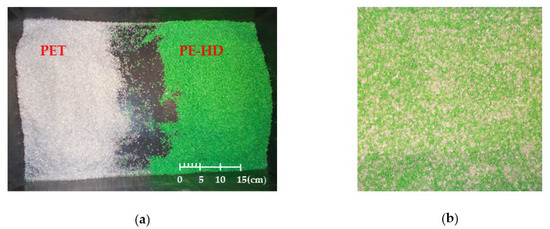
Figure 1.
PET and PE-HD test material with grain size of 1.8–2.8 mm (a) before mixing; (b) after mixing.
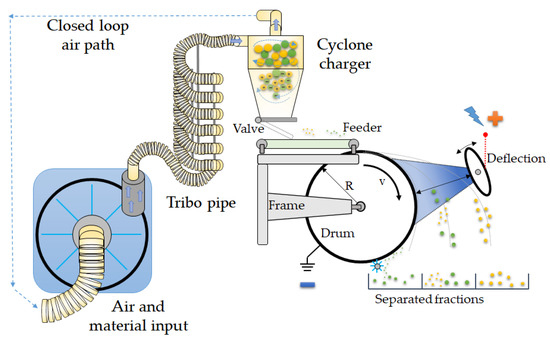
Figure 2.
The automated test bench of the tribocharging and separation process.
In order to electrify particles of the materials under study in the tribocharging process, a system shown in Figure 3a was developed, built, and used by the authors. In this system, in order to create a strong air flow, a professional blower, Cormak FM300 (CORMAK, Siedlce, Poland), with a suction capacity of 2530 m3/h was applied. The blower fan is driven by a three-phase motor with a capacity of 1.5 kW and a rated speed of 2850 rpm. The motor is supplied by a 3G3MX2-A4015-E inverter (OMRON Co. Kyoto, Japan) (Figure 3b) with a voltage of adjustable frequency within the range of 45–70 Hz, which made it possible to obtain an air output in the range of 2.16–3.68 cpm. The applied blower, after sucking in the particles of the tested materials, blows them into a 10-metre-long polyurethane (PU) tube with a diameter of 30 mm, coiled into a spiral, and then blows the particles into a conical cyclone. The tested material circulates in the cyclone and the PU pipe and is electrified. The capacity of the particles to be electrically charged in the PU tube and the cyclone was, therefore, investigated independently for both devices. Faraday buckets connected to a JCI 178X (Chilworth Technology Ltd. PHI House, Southampton Science Park, UK) Charge Measuring Unit (Figure 4) were used to measure the accumulated charge of the particles in both materials.

Figure 3.
Tribocharger setup (a) and control cabinet (b).
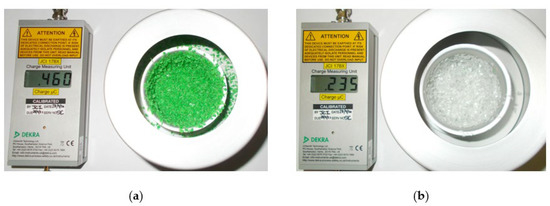
Figure 4.
A system for measuring the accumulated charge on particles of (a) PE-HD and (b) PET polymers.
In further studies, the mixed particles of both materials in the same weight proportions were subjected to the process of electrical charging (tribocharging) in the system presented in Figure 3a. The electrified particles were then delivered onto the belt conveyor of the separator built by the authors (Figure 5a) [22,23]. The separation efficiency of the process was evaluated with the use of a vision system developed by the authors (Figure 5b), by observing the changing speed of the conveyor belt and negative electrode roller [22,23]. The vision system allowed for the percentage assessment of the degree of separation for individual collectors treated as the region of interests (ROI, Figure 5b-1). The starting point was an image (taken by the camera in Figure 5b-2) filtered using the HSV color palette. Before the tests, the vision system setup was calibrated for the tested material. The calibration procedure and a detailed description of the vision system were presented by the authors in [22]. To evaluate the impact of the selected parameters of the separation process, two figures of merit have been proposed: the recovery rate (RR) and purity (PUR). These quality factors refer to data summarized in Table 1, nevertheless, it should be emphasized that since the proposed assessment method is based on a vision system, the RR and PUR factors cannot be treated directly as absolute values. The recovery rate is calculated using the following formula:
where: mr is the estimated mass of the recovered material of required purity (RP), mw is the estimated mass of the material of purity less than RP, mri and mwi are estimated by the analysis of each ROI.
where: i denotes the ROI number, l is the numbers of ROI segments.
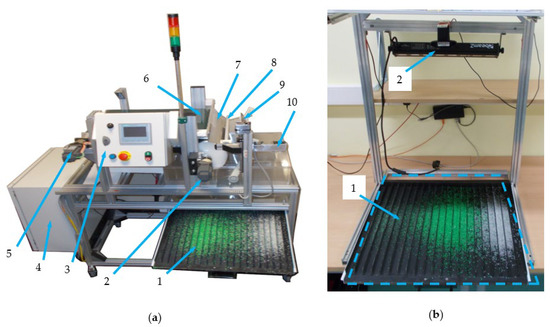
Figure 5.
The view of electrostatic separator (a) 1-collector of material pickup (analysed material), 2-drum drive, 3-HMI control panel, 4-control cabinet, 5-feeder drive and stand for the vision system, 6-feeder, 7-drum, 8-corona electrode, 9-defecting electrode, 10-electrode positioning system, (b) 1-analyzed material, 2-camera.
The purity parameter represents the purity of recovered material from the mixture of A (PET) and B (PE-HD) materials. The parameter PUR is calculated as the average value of purities of the separated materials PUA and PUB, respectively.
where PUj represents the purity of the j–th material and is calculated as follows:
here mAR and mBR are the estimated masses of recovered materials A and B, respectively; while mBW and mAW are the estimated masses of materials B and A in mAR and mBR, respectively.
The influence of the position of the deflecting electrode on the separation efficiency of the materials studied was also examined. Both the angle of inclination and the distance of the deflecting electrode from the drum discharging the separated particles into containers (ROIs) were changed. Figure 6 shows a selection of two different positions of the deflecting electrode for which separation quality tests were performed.
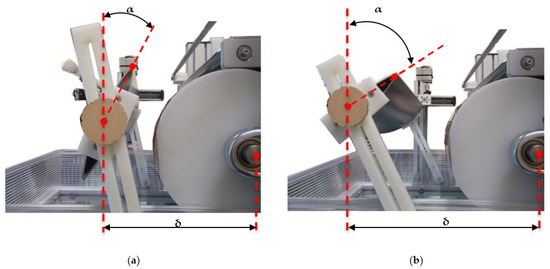
Figure 6.
Considered positions of the deflecting electrode: position I (a) α = 13°, δ = 150 mm andposition II (b) α = 48°, δ = 210 mm.
3. Results and Discussion
In the course of the research carried out, the efficiency of electrical charging of PET and PE-HD particles in elements of the system used for tribocharging (Figure 3a), i.e., the PU tube and cyclone, was the first thing checked. The tests were carried out at the voltage supplying the motor driving the blower with a frequency of 70 Hz. The blower first sucked the area of one end of the closed circuit in the PU tube and then blew particles of the analyzed materials into the other end of the PU tube. During the process of rubbing the particles against the walls of the PU tube, the particles were electrified. The duration of the charging process of 10 g particles for both tested materials was varied up to 8 min. Afterwards, the charge accumulated in PET and PE-HD particles was measured. The obtained results are illustrated in Figure 7a,b, respectively. At the same blower settings, the particles of both materials were electrified inside the cyclone. The duration of the charging process for PET and PE-HD particles of 10 g inside the cyclone lasted also up to 8 min. The results of the measurements of the charge accumulated in the particles of both materials during this research are presented in Figure 7c,d, respectively.
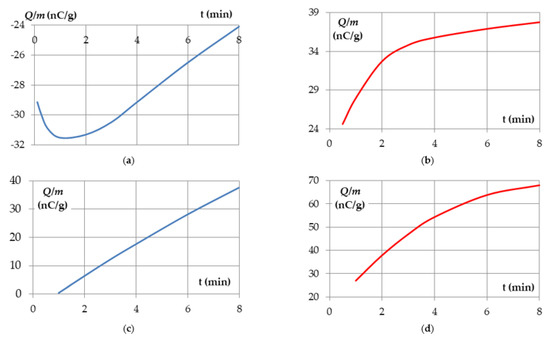
Figure 7.
Charge density Q/m as a function of time t tribocharging in a PU tube for PET (a) and PE-HD particles (b) and in a cyclone for PET (c) and PE-HD particles (d).
Next, the separation efficiency of the mixed material (50 g PET+50 g PE-HD particles) was tested. The tests were carried out at a blower air flow rate of 3.68 cpm in the constructed system (Figure 3a). The duration of the tribocharging process was varied up to 8 min. The electrified particles of the mixture of both materials were separated in a separator (Figure 5a) and the efficiency of this separation was evaluated in the vision system (Figure 5b). The obtained results of selected separation tests are shown in Figure 8, Figure 9 and Figure 10.

Figure 8.
Results after 8 min of tribocharging and separation: (a) percentage of PET and PE-HD in each ROI segments; (b) percentage of PET and PE-HD in relation to the surface of the ROI segments.

Figure 9.
Results after 5 min. of tribocharging and separation: (a) percentage of PET and PE-HD in each ROI segments; (b) percentage of PET and PE-HD in relation to the surface of the ROI segments.
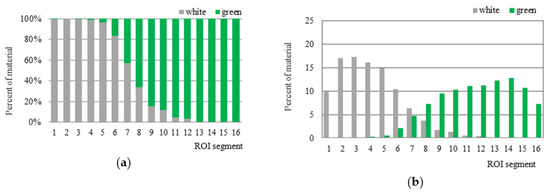
Figure 10.
Results after 1 min. of tribocharging and separation: (a) percentage of PET and PE-HD in each ROI segments; (b) percentage of PET and PE-HD in relation to the surface of the ROI segments.
The separation efficiency tests carried out using the developed vision system showed that the separation efficiency rapidly improves when the tribocharging time for the particle mixture of both materials in the range of up to about 5 min was increased. Further extending the tribocharging time only slightly improved the separation efficiency. Therefore, further studies of that separation efficiency and quality were performed for a tribocharging time of 5 min. The influence of the position of the deflecting electrode (Figure 11) and the drum rotational speed on RR and PUR of the separated PET and PE-HD particles was analysed.
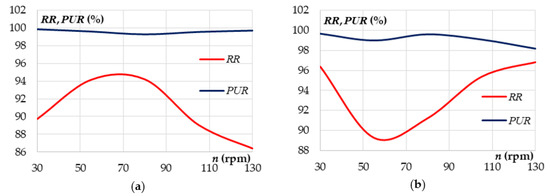
Figure 11.
Dependence of recovery rate (RR) and purity factors (PUR) on rotary speed of the drum electrode for mixture of PET (50%) and PE-HD (50%) tribocharged by 5 min for deflecting electrode position I (a) and II (b).
4. Conclusions
The paper presents the results of research on the electrostatic separation of plastics. In order to enable the evaluation of the proposed approach, a comparative analysis of various solutions for electrostatic separators and systems, based on the literature review, was included in the introductory part of the paper. The presented research was carried out using a developed test stand consisting of a drum separator, a tribocharger, and a dedicated vision system enabling quick and effective assessment of the separation process quality.
The research on the tribocharging efficiency of the studied PET and PE-HD particles in the tribocharging system showed that PE-HD particles have a greater ability to accumulate a positive charge. This causes them to be more attracted to the negative electrode (drum) of the separator. On the basis of the obtained results, it was stated that the charging efficiency of PE-HD particles after about 4–5 min in the cyclone does not increase as fast as that of PET particles and begins to stabilize (saturate). Also, the evaluation of the separation efficiency of the mixture for both materials performed with the developed vision system showed a visible improvement of the separation efficiency of the particles for both materials when increasing the tribocharging time to about 5 min. The tests of separation efficiency and quality for this tribocharging time when changing the drum speed and deflecting electrode setting showed that:
- the most favourable separation at a short distance from the drum with the positive (deflecting) electrode weakly deviating from the vertical position can be obtained when the drum speed is about 70 rpm;
- the least favourable separation at a large distance from the drum with the positive (deflecting) electrode strongly deviated from the vertical position is obtained at a drum speed of approx. 55–60 rpm; the recovery rate (RR), in this variant, increases with the increasing drum speed.
The performed research confirms the benefits of further work on improving the methods for efficient separation of plastics for reprocessing.
Author Contributions
Conceptualization, W.L., C.J.; methodology, W.L., M.B. and D.R.; validation, W.L., D.R. and R.R.; formal analysis, C.J., M.B., R.R. and J.M.; investigation, W.L., J.M., D.R. and C.J.; software, D.R., D.S.; data curation, C.J., W.L. and D.R; writing—original draft preparation, W.L., M.B., R.R. and J.M.; writing—review and editing, W.L., C.J., D.R., R.R. and M.B.; supervision, C.J.; project administration, C.J., D.S., funding acquisition., C.J., D.S. All authors have read and agreed to the published version of the manuscript.
Funding
This research was funded by Rector’s Grant of Poznan University of Technology, grant number 33/32/SIGR/0005.
Institutional Review Board Statement
Not applicable.
Informed Consent Statement
Not applicable.
Data Availability Statement
Not applicable.
Conflicts of Interest
The authors declare no conflict of interest.
References
- Geyer, R.; Jambeck, J.R.; Law, K.L. Production, Use, and Fate of All Plastics Ever Made. Sci. Adv. 2017, 3, e1700782. [Google Scholar] [CrossRef] [Green Version]
- Solid Waste Management. Available online: https://www.worldbank.org/en/topic/urbandevelopment/brief/solid-waste-management (accessed on 10 June 2021).
- Plastics—The Facts. 2020. Available online: https://plasticseurope.org/knowledge-hub/plastics-the-facts-2020/ (accessed on 16 June 2021).
- Starodubova, A.; Iskhakova, D.; Misbakhova, C. Analysis of the Global Market of Technologies in the Field of Collection, Sorting and Recycling of Polymer Waste. E3S Web Conf. 2021, 247, 01005. [Google Scholar] [CrossRef]
- European Parliament and the Council of the European Union. Directive (EU) 2018/852 of the European Parliament and of the Council of 30 May 2018 Amending Directive 94/62/EC on Packaging and Packaging Waste (Text with EEA Relevance). Off. J. Eur. Union 2018, 150, 141–154. [Google Scholar]
- Wu, G.; Li, J.; Xu, Z. Triboelectrostatic Separation for Granular Plastic Waste Recycling: A Review. Waste Manag. 2013, 33, 585–597. [Google Scholar] [CrossRef] [PubMed]
- Samuila, A.; Dascalescu, L.; Calin, L.; Bilici, M.; Catinean, A. Recent Researches in Electrostatic Separation Technologies for the Recycling of Waste Electric and Electronic Equipment. In Proceedings of the AIP Conference TIM 19 Physics Conference, Timisoara, Romania, 29–31 May 2019; Volume 2218, pp. 030001.1–030001.10. [Google Scholar]
- Vermeșan, H.; Tiuc, A.-E.; Purcar, M. Advanced Recovery Techniques for Waste Materials from IT and Telecommunication Equipment Printed Circuit Boards. Sustainability 2019, 12, 74. [Google Scholar] [CrossRef] [Green Version]
- Meneses Quelal, W.O.; Velázquez-Martí, B.; Ferrer Gisbert, A. Separation of Virgin Plastic Polymers and Post-Consumer Mixed Plastic Waste by Sinking-Flotation Technique. Environ. Sci. Pollut. Res. 2021. [Google Scholar] [CrossRef]
- Mumbach, G.D.; de Sousa Cunha, R.; Machado, R.A.F.; Bolzan, A. Dissolution of Adhesive Resins Present in Plastic Waste to Recover Polyolefin by Sink-Float Separation Processes. J. Environ. Manag. 2019, 243, 453–462. [Google Scholar] [CrossRef]
- Serranti, S.; Bonifazi, G. Techniques for Separation of Plastic Wastes. In Use of Recycled Plastics in Eco-Efficient Concrete; Environmental Science Conference: Amsterdam, The Netherlands, 2019; pp. 9–37. [Google Scholar]
- Da Silva, D.J.; Wiebeck, H. Current Options for Characterizing, Sorting, and Recycling Polymeric Waste. Prog. Rubber Plast. Recycl. Technol. 2020, 36, 284–303. [Google Scholar] [CrossRef]
- Xue, M.; Yan, G.; Li, J.; Xu, Z. Electrostatic Separation for Recycling Conductors, Semiconductors, and Nonconductors from Electronic Waste. Environ. Sci. Technol. 2012, 46, 10556–10563. [Google Scholar] [CrossRef]
- Xing, Q.; Kyriakopoulou, K.; de Wit, M.; Boom, R.M.; Schutyser, M.A.I. Effect of Tube Wall Material on Electrostatic Separation of Plant Raw-Materials. J. Food Process Eng. 2021, 44, e13575. [Google Scholar] [CrossRef]
- Zhu, H.-G.; Tang, H.-Q.; Cheng, Y.-Q.; Li, Z.-G.; Tong, L.-T. Electrostatic Separation Technology for Obtaining Plant Protein Concentrates: A Review. Trends Food Sci. Technol. 2021, 113, 66–76. [Google Scholar] [CrossRef]
- Landauer, J. Triboelectric Separation—A New Method to Separate Fine Organic Powders? Ph.D. Thesis, Technical University of Münch, Münch, Germany, 2020. [Google Scholar]
- Moiseev, V.A.; Andrienko, V.G.; Piletskii, V.G.; Donchenko, V.A.; Urvantsev, A.I. Beneficiation of Heat-Treated Crushed Brown Coal for Energy Production and Utilities. In Proceedings of the Scientific-Practical Conference “Research and Development-2016”, Moscow, Russia, 14–15 December 2016; p. 305. [Google Scholar]
- Calin, L.; Cătinean, A.; Bilici, M.; Dăscălescu, L.; Samuilă, A. Electrostatic Separation of HIPS/ABS and HIPS/ABS-PC Plastic Mixtures from IT Equipment Using Fluidized Bed Tribocharging. Part. Sci. Technol. 2021, 1–10. [Google Scholar] [CrossRef]
- Prawatya, Y.E. Multivariate Optimisation and Statistical Process Control of Polymer Triboelectric Charging. Ph.D. Thesis, Université de Poitiers, Poitiers, France, 2018. [Google Scholar]
- Li, J.; Wu, G.; Xu, Z. Tribo-Charging Properties of Waste Plastic Granules in Process of Tribo-Electrostatic Separation. Waste Manag. 2015, 35, 36–41. [Google Scholar] [CrossRef]
- Regulski, R.; Czarnecka-Komorowska, D.; Jędryczka, C.; Sędziak, D.; Rybarczyk, D.; Netter, K.; Barański, M.; Barczewski, M. Automated Test Bench for Research on Electrostatic Separation in Plastic Recycling Application. Bull. Pol. Acad. Sci. Tech. Sci. 2021, 69, e136719. [Google Scholar]
- Rybarczyk, D.; Jędryczka, C.; Regulski, R.; Sędziak, D.; Netter, K.; Czarnecka-Komorowska, D.; Barczewski, M.; Barański, M. Assessment of the Electrostatic Separation Effectiveness of Plastic Waste Using a Vision System. Sensors 2020, 20, 7201. [Google Scholar] [CrossRef]
- Lyskawinski, W.; Baranski, M.; Jedryczka, C.; Mikolajewicz, J.; Regulski, R.; Sedziak, D.; Netter, K.; Rybarczyk, D.; Czarnecka-Komorowska, D.; Barczewski, M. Tribo-Electrostatic Separation Analysis of a Beneficial Solution in the Recycling of Mixed Poly(Ethylene Terephthalate) and High-Density Polyethylene. Energies 2021, 14, 1755. [Google Scholar] [CrossRef]
- Kimi, I.E.; Miloudi, M.; Touhami, S.; Fekir, D.-E.; Tilmatine, A. Experimental Investigation of a Modified Free-Fall Tribo-Electrostatic Separator with Rotating Electrodes. Part. Sci. Technol. 2021, 1–9. [Google Scholar] [CrossRef]
- Rodrigues, B.M.; Saron, C. Electrostatic Separation of Polymer Waste by Tribocharging System Based on Friction with PVC. Int. J. Environ. Sci. Technol. 2021. [Google Scholar] [CrossRef]
- Li, J.; Xu, Z. Compound Tribo-Electrostatic Separation for Recycling Mixed Plastic Waste. J. Hazard. Mater. 2019, 367, 43–49. [Google Scholar] [CrossRef] [PubMed]
- Bouhamri, N.; Zelmat, M.E.; Tilmatine, A. Micronized Plastic Waste Recycling Using Two-Disc Tribo-Electrostatic Separation Process. Adv. Powder Technol. 2019, 30, 625–631. [Google Scholar] [CrossRef]
- Reriballah, H.; Aksa, W.; Touhami, S.; Medles, K.; Zeghloul, T.; Dascalescu, L. Experimental Modeling and Optimization of a Free-Fall Electrostatic Separator Equipped with Four Rotating-Cylinder Electrodes. IEEE Trans. Ind. Appl. 2020, 56, 5472–5479. [Google Scholar] [CrossRef]
- Achouri, I.E.; Zeghloul, T.; Richard, G.; Medles, K.; Dascalescu, L.; Senouci, K. Endurance Test for Evaluating the Performances of a Novel Rotating-Cylinder-Type Triboelectric Charging Device. IEEE Trans. Ind. Appl. 2020, 56, 7005–7011. [Google Scholar] [CrossRef]
- Benabderrahmane, A.; Zeghloul, T.; Aksa, W.; Tilmatine, A.; Medles, K.; Dascalescu, L. Shredding as Simultaneous Size-Reduction and Tribo-Charging Operation for Improved Performances of an Electrostatic Separation Process for Granular Plastic Wastes. Part. Sci. Technol. 2020, 38, 827–834. [Google Scholar] [CrossRef]
- Brahami, Y.; Tilmatine, A.; Benabboun, A.; Bousmaha, I.S. Experimental Investigation of a Tribo-Electrostatic Separation Device Using Linear Moving Electrodes. Part. Sci. Technol. 2020, 39, 657–662. [Google Scholar] [CrossRef]
- Reriballah, H.; Aksa, W.; Boukhoulda, M.F.; Touhami, S.; Medles, K.; Tilmatine, A. Realization and Optimization of a New Inclined Plane Electro-Separator. In Proceedings of the 2019 International Conference on Advanced Electrical Engineering (ICAEE), Algiers, Algeria, 19–21 November 2019; pp. 1–6. [Google Scholar]
- Younes, A.; Younes, M.; Sayah, H.; Samuila, A.; Dascalescu, L. Experimental and Numerical Modeling of a New Tribo-Electrostatic Separation Process for Granular Plastics Mixtures. Part. Sci. Technol. 2015, 33, 189–196. [Google Scholar] [CrossRef]
- Li, T.; Yu, D.; Zhang, H. Triboelectrostatic Separation of Polypropylene, Polyurethane, and Polyvinylchloride Used in Passenger Vehicles. Waste Manag. 2018, 73, 54–61. [Google Scholar] [CrossRef]
- Silveira, A.V.M.; Cella, M.; Tanabe, E.H.; Bertuol, D.A. Application of Tribo-Electrostatic Separation in the Recycling of Plastic Wastes. Process Saf. Environ. Prot. 2018, 114, 219–228. [Google Scholar] [CrossRef]
- Benaouda, I.; Zeghloul, T.; Medles, K.; Zelmat, M.E.-M.; Tilmatine, A.; Dascalescu, L. Insulating Conveyor-Belt-Type Electrostatic Separator for Triboelectrically-Charged Granular Plastic Wastes. In Proceedings of the IEEE Industry Applications Society Annual Meeting, Baltimore, MD, USA, 29 September–3 October 2019; pp. 1–4. [Google Scholar]
- Messafeur, R.; Mahi, I.; Ouiddir, R.; Medles, K.; Dascalescu, L.; Tilmatine, A. Tribo-Electrostatic Separation of a Quaternary Granular Mixture of Plastics. Part. Sci. Technol. 2019, 37, 764–769. [Google Scholar] [CrossRef]
- Rezoug, M.; Aksa, W.; Boukhoulda, M.F.; Medles, K.; Dascalescu, L. A Novel Tribo-Electrostatic Device for the Treatment of Granular Waste Plastics Mixtures. Int. J. Environ. Stud. 2019, 76, 225–235. [Google Scholar] [CrossRef]
Publisher’s Note: MDPI stays neutral with regard to jurisdictional claims in published maps and institutional affiliations. |
© 2021 by the authors. Licensee MDPI, Basel, Switzerland. This article is an open access article distributed under the terms and conditions of the Creative Commons Attribution (CC BY) license (https://creativecommons.org/licenses/by/4.0/).